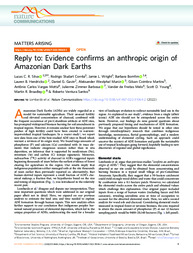Reply to: Evidence confirms an anthropic origin of Amazonian Dark Earths.
Reply to: Evidence confirms an anthropic origin of Amazonian Dark Earths.
Author(s): SILVA, L. C. R.; CORRÊA, R. S.; WRIGHT, J. L.; BOMFIM, B.; HENDRICKS, L. B.; GAVIN, D. G.; MUNIZ, A. W.; MARTINS, G. C.; MOTTA, A. C. V.; BARBOSA, J. Z.; MELO, V. de F.; YOUNG, S. D.; BROADLEY, M. R.; SANTOS, R. V.
Summary: REPLYING to Lombardo et al. Nature Communications https://doi.org/10.1038/s41467-022-31064-2 (2022). Amazonian Dark Earths (ADEs) are widely regarded as a model for sustainable agriculture. Their unusual fertility and elevated concentration of charcoal, combined with the frequent occurrence of pre-Columbian artifacts at ADE sites, has prompted widespread biomass burning for soil amendment in tropical regions. However, it remains unclear how these persistent patches of high fertility could have been created in nutrient-impoverished tropical landscapes. In a recent study 1 , we report new data from one of the best-studied ADE sites in Brazil which warrant a revision of its origin story. We found large amounts of phosphorus (P) and calcium (Ca) correlated with 16 trace elements that indicate exogenous sources rather than in situ deposition, an inference that is supported by neodymium (Ne), strontium (Sr) and carbon (C) isotope signatures. Moreover, radiocarbon ( 14 C) activity of charcoal in ADEs suggested inputs beginning thousands of years before the earliest evidence of forest clearing for agriculture in the region. Our results imply that indigenous populations either managed soils at the site thousands of years earlier than previously reported or, alternatively, that human-derived inputs represent a small fraction of ADE’s chemical makeup, a fraction that, we hypothesise based on the size and timing of deposition (Fig. 1), was introduced in the relatively recent past. Lombardo et al.2 disagree and dispute our interpretation. They raise important questions which were addressed in our original paper albeit not in detail. Here, we expand on our previous analysis to estimate the land area and time needed to explain ADE formation through human inputs. This new analysis offers further support to our conclusion that indigenous peoples harnessed natural processes of elemental deposition, which led to the unique properties of ADEs, underscoring the need for a broader view of landscape evolution to redirect sustainable land use in the region. As explained in our study1, evidence from a single (albeit iconic) ADE site should not be extrapolated across the entire basin. However, our findings do raise general questions about previously proposed timing and mechanisms of ADE formation. We argue that our hypothesis should be tested in other sites through interdisciplinary research that combines indigenous knowledge, neotectonics, fluvial geomorphology, and a modern understanding of elemental cycling. Such an approach could uncover the mystery of ADE formation and guide the sustainable use of tropical landscapes going forward, hopefully leading to new discoveries of regional and global significance.
Publication year: 2022
Types of publication: Journal article
Unit: Embrapa Western Amazon
Keywords: Terra Preta de Índio
Observation
Some of Embrapa's publications are published as ePub files. To read them, use or download one of the following free software options to your computer or mobile device. Android: Google Play Books; IOS: iBooks; Windows and Linux: Calibre.
Access other publications
Access the Agricultural Research Database (BDPA) to consult Embrapa's full library collection and records.
Visit Embrapa Bookstore to purchase books and other publications sold by Embrapa.

